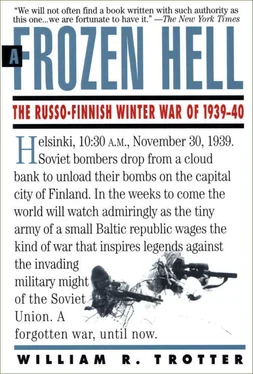William Trotter - A Frozen Hell
Здесь есть возможность читать онлайн «William Trotter - A Frozen Hell» весь текст электронной книги совершенно бесплатно (целиком полную версию без сокращений). В некоторых случаях можно слушать аудио, скачать через торрент в формате fb2 и присутствует краткое содержание. Город: Chapel Hill, Год выпуска: 2000, ISBN: 2000, Издательство: Algonquin Books of Chapel Hill, Жанр: military_history, История, на английском языке. Описание произведения, (предисловие) а так же отзывы посетителей доступны на портале библиотеки ЛибКат.
- Название:A Frozen Hell
- Автор:
- Издательство:Algonquin Books of Chapel Hill
- Жанр:
- Год:2000
- Город:Chapel Hill
- ISBN:978-1565122499
- Рейтинг книги:3 / 5. Голосов: 1
-
Избранное:Добавить в избранное
- Отзывы:
-
Ваша оценка:
- 60
- 1
- 2
- 3
- 4
- 5
A Frozen Hell: краткое содержание, описание и аннотация
Предлагаем к чтению аннотацию, описание, краткое содержание или предисловие (зависит от того, что написал сам автор книги «A Frozen Hell»). Если вы не нашли необходимую информацию о книге — напишите в комментариях, мы постараемся отыскать её.
A Frozen Hell — читать онлайн бесплатно полную книгу (весь текст) целиком
Ниже представлен текст книги, разбитый по страницам. Система сохранения места последней прочитанной страницы, позволяет с удобством читать онлайн бесплатно книгу «A Frozen Hell», без необходимости каждый раз заново искать на чём Вы остановились. Поставьте закладку, и сможете в любой момент перейти на страницу, на которой закончили чтение.
Интервал:
Закладка:
The outbreak of the First World War gave the more militant Finnish nationalists a window of opportunity—now, they argued, was the time to prepare for the armed overthrow of the Russian yoke. In seeking military assistance, the Finns operated on the time-honored but dangerously simplistic theory that the enemy of one’s enemy is also one’s friend. They sought aid from both Germany and the Bolsheviks; both connections would haunt them for decades to come, in very different ways.
About 2,000 young Finns went to Germany for professional military training in 1915 and 1916, where they were carried on the Imperial army’s order of battle as the “Twenty-seventh Prussian Jaeger Battalion.” Almost every successful Finnish field commander in both the Civil War and the Winter War received his basic training in the Twenty-seventh Jaegers; veterans of that unit became, for all practical purposes, an elite professional caste.
On November 15, 1917, the Finnish Parliament openly assumed responsibility for Finnish affairs, internal and external. Lenin could spare no troops and very little attention for this sideshow of secession. Instead, he purchased Finnish neutrality vis-à-vis Russia’s internal power struggle by recognizing the new Finnish government just three weeks after Finland’s formal declaration of independence.
Finland did not escape the widening class struggles that threatened to tear European society apart in the closing months of World War I. Its working class had endured years of worsening conditions, wartime shortages, famines, and a declining standard of living. Constant Bolshevik agitation had aggravated the situation to the point that two rival armies had formed. Domestic Communists, discontented workers and peasants, and a small but volatile assortment of homegrown anarchists all went into the ranks of the Red Guard, which was armed, trained, and fleshed out by some 40,000 Russian soldiers stationed in Finland, many of them flaming revolutionaries. The White Guard was the militant arm of the upper classes and the bourgeoisie; their commander was Carl Gustav Mannerheim, a former tsarist general recently returned to his native land.
Although the Reds held the best ground—Helsinki and the industrial center of Tampere—the Whites had an edge in terms of military professionalism; many White units were led by former tsarist officers, and the Jaeger Battalion alumni quickly demonstrated a tactical expertise that the Reds could not match. Although Mannerheim opposed it—believing that Finland was in danger of mortgaging her political future—the White government requested aid from Imperial Germany, and an expeditionary force landed in April 1918. With this new infusion of firepower, the Whites proved unstoppable; six weeks after the Germans landed, the Reds surrendered.
The Treaty of Tartu, signed in 1920, formalized a state of peace between Finland and the USSR. From the Soviet government, Finland gained recognition and the arctic port of Petsamo; for its part, Finland destroyed all the fortifications on the islands in the Gulf of Finland. The questions of what to do with the denizens of East Karelia, Finnish by heritage but Russian by law and circumstances, remained unresolved and would exert a baleful influence on Finnish diplomacy in years to come.
Thus ended the long and peculiar relationship between Finland and Imperial Russia. What had mostly changed by 1920, aside from the configuration of the border, was the two nations’ attitudes toward each other. Trust had been badly eroded on both sides. The Finns had learned to fear Bolshevism, and the Soviets were uncomfortable with a neighbor that had opted for a thoroughly bourgeois system of government, had violently suppressed its own workers, and had made room in its diplomatic bed for the German enemy.
The men who ran Finland’s postwar governments did much for their country. They moved to bind the internal wounds, to lay the foundations of economic growth, and to improve—in some respects very dramatically—the standard of living. But in the realm of foreign relations, they tended simply to mind their own business and assume other states would mind theirs. Their postwar policy with regard to the Soviet Union was one of shutting their eyes and hoping it would go away. During the early years of Lenin’s regime, when the Soviet state was fragmented by internal strife and beset from without by interventionist armies, that approach was sufficient. But by the end of the 1920s, with the Soviet system consolidated and Russia once more becoming a powerful factor in international affairs, the Finns should have seen clearly that sooner or later their giant eastern neighbor would want to have words with them about some sensitive issues.
Seeds of future war had in fact been planted at the moment of Finland’s birth. Lenin’s government had bitterly resented having to give up Finland so compliantly, but at the time it was done, Lenin was beset by so many other and far more dangerous and immediate threats that he simply had no alternative. The Politburo assumed that propaganda, internal domestic unrest, and a bit of routine subversion would ultimately be enough to bring Finland back into the Communist sphere.
When Joseph Stalin came to power, he did so with diplomatic perceptions that were deeply and permanently colored by his memories of the early days of the Russian civil war, when the White government of Finland had allowed both the Russian Whites and some units of the British Navy to launch attacks from the Finnish coast against Bolshevik targets in the Baltic. Stalin viewed the demilitarization of the Baltic islands—in particular the huge Aaland archipelago, a vast and beautiful necklace of hundreds of islets that lies between the land mass of Sweden and the southwest coast of Finland—with a skeptical eye; it was clear to him that any great power who wanted those islands could seize them at will, and Finland could do nothing to stop it. Control of the Aalands and of the islands in the Gulf of Finland meant control of the flow of naval traffic in the Baltic, including ship movements in and out of Leningrad and Kronstadt.
Furthermore, the discovery of large nickel deposits in the Petsamo region had altered the strategic picture considerably. Mining concessions had been given by the Finns to a British Empire consortium, and it was well known that much of Germany’s iron ore came from the not-too-distant mines in northern Sweden. Thus, when Stalin came to power, there were already two Great Powers—the two, as it happened, that Stalin most feared—keenly interested in the bleak and barely habitable Arctic coast of Finland.
Completion of the Murmansk Railroad, connecting Leningrad with one of Russia’s few ice-free ports, was a further source of anxiety. The land through which this vital rail line passed, in East Karelia, was often the subject of loud irredentist claims made by right-wing elements in Finnish politics. Stalin was enough of a realist to know that the Finns themselves would never dare attempt the annexation of that region by force, but it seemed at least theoretically possible that another hostile nation—Germany, for instance—might offer the Karelian provinces in exchange either for Finnish military cooperation or for simple acquiescence to the deployment of foreign soldiers on Finnish soil. Finland’s protestations of neutrality, however sincerely meant, counted for little in the harsh equations of realpolitik. It was the Kremlin’s belief that, in the event of another big European war, Finland would simply not be allowed to remain neutral. And the Finnish border, at its closest point, was still a mere thirty-two kilometers from the outskirts of Leningrad.
From 1918 until just before the outbreak of war in 1939, Finland’s ruling politicians seem to have been remarkably obtuse when it came to understanding the Russian point of view. Not until about 1935 did the Finns realize that everything they did and said was subject to Soviet misinterpretation. It was largely in an effort to redress this attitude that the Finns launched, with great public fanfare, a policy of pan-Scandinavian neutrality. The Soviet intelligence service read the papers and heard the speeches on the radio but drew the wrong conclusions from the data they perceived.
Читать дальшеИнтервал:
Закладка:
Похожие книги на «A Frozen Hell»
Представляем Вашему вниманию похожие книги на «A Frozen Hell» списком для выбора. Мы отобрали схожую по названию и смыслу литературу в надежде предоставить читателям больше вариантов отыскать новые, интересные, ещё непрочитанные произведения.
Обсуждение, отзывы о книге «A Frozen Hell» и просто собственные мнения читателей. Оставьте ваши комментарии, напишите, что Вы думаете о произведении, его смысле или главных героях. Укажите что конкретно понравилось, а что нет, и почему Вы так считаете.












